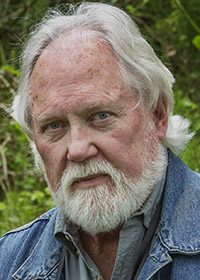 Dr. Robert Michael Pyle, independent scholar, writer, biologist, and educator, is internationally honored for his devotion to insect conservation (particularly as founder of the Xerces Society), promoting public awareness and enjoyment of butterflies, and contributions to natural history and place-based literature.
Dr. Robert Michael Pyle, independent scholar, writer, biologist, and educator, is internationally honored for his devotion to insect conservation (particularly as founder of the Xerces Society), promoting public awareness and enjoyment of butterflies, and contributions to natural history and place-based literature.
Born in Denver, Colorado, in 1947, Pyle attended Aurora Public Schools. His first grant, in high school, was from the Colorado-Wyoming Academy of Science for wood nymph (Cercyonis) studies. Meeting Charles Remington, Paul Ehrlich, John A. Comstock, and other prominent lepidopterists as a boy was a tremendous influence on his future studies. He took his B.S. (nature perception and protection, 1969) and M.S. (nature interpretation, 1973) at the University of Washington. After a Fulbright scholarship in butterfly conservation with John Heath at Monks Wood Experimental Station, Abbots Ripton, UK, he joined Remington at Yale University for his Ph.D. on “The Eco-Geography of Lepidoptera Conservation” (1976). Thereafter he was giant birdwing conservation consultant for the Wildlife Division of Papua New Guinea; Northwest land steward for The Nature Conservancy; and co-manager and invertebrate red data book compiler at the Species Conservation Monitoring Center at Cambridge University. In 1982 he became independent. He has been a visiting professor at Utah State University, The Evergreen State College, and the University of Montana.
Pyle’s Watching Washington Butterflies and Handbook for Butterfly Watchers were the first American books promoting butterfly watching alongside collecting, an activity now developed far beyond his dreams. His Audubon Society Field Guide to the Butterflies of North America, still in print and widely used after 40 years, was the first to cover the entire fauna and to use photographs from life. He is best known for founding the Xerces Society for Invertebrate Conservation in 1971. Xerces now has a staff of more than 50, some prominent entomologists among them, and is the largest pollinator protection team in the world. With Remington and Sarah Hughes, Pyle initiated the annual butterfly counts that thousands now undertake. He was the first to attempt to follow the monarch migration, reported in Chasing Monarchs and papers with Lincoln Brower, demonstrating a new model for the migration. Pyle’s several hundred publications include 27 refereed papers and major reports and two Annual Review articles. His 25 books include Wintergreen, The Thunder Tree, Mariposa Road, Nature Matrix (finalist for the 2021 PEN America Award for the Art of the Essay); five collections of poetry; the novel Magdalena Mountain; and Butterflies of the Pacific Northwest.
An Honorary Fellow of the Royal Entomological Society and 62-year member of the Lepidopterists’ Society, Pyle has received a Guggenheim Fellowship, the John Burroughs Medal, two National Outdoor Book Awards, and a Distinguished Service Award from the Society of Conservation Biology. He has described nine new taxa of butterflies and has one patronym, a myriapod.
In the absence of his late beloved wife Thea Linnaea, Pyle continues to read, write, track butterflies, and study the natural history of his rainforest enclave in the Willapa Hills of southwest Washington.
